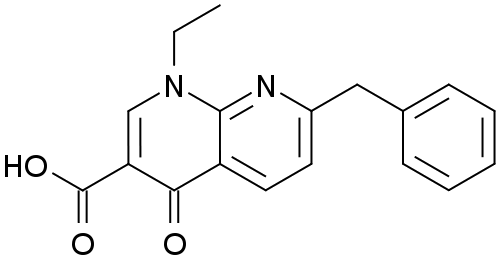Summary
Amfonelic acid (AFA), also known as WIN 25,978, is a research compound and dopaminergic stimulant that possesses antibiotic characteristics. While there is a scarcity of extensive clinical trials involving AFA, it is predominantly employed within the realm of scientific research.
| Identifiers | |
|---|---|
| IUPAC name | |
| CAS Number | 15180-02-6 |
|---|---|
| PubChem CID | 2137 |
| ChemSpider | 2052 |
| UNII | RR302AR19Y |
| KEGG | D02897 |
| ChEMBL | ChEMBL35337 |
| CompTox Dashboard (EPA) | DTXSID40164877 |
| Chemical and physical data | |
| Formula | C18H16N2O3 |
| Molar mass | 308.337 g·mol−1 |

History
The stimulating attributes of AFA were serendipitously discovered during research conducted at Sterling-Winthrop while investigating the antibiotic nalidixic acid. In addition to its antibiotic properties, it became evident that various derivatives of nalidixic acid had either stimulating or depressant effects on the central nervous system. Sterling-Winthrop researchers identified AFA as having a notably higher potency and therapeutic index compared to cocaine or amphetamine, prompting further investigation. Although a limited number of clinical trials took place in the 1970s, these trials were discontinued upon observing that AFA exacerbated psychotic symptoms in schizophrenic patients and induced undesirable stimulating effects in elderly individuals suffering from depression. Nevertheless, AFA continues to be a widely employed pharmacological tool for exploring the brain’s reward system, dopamine pathways, and the dopamine transporter. Since 2013, AFA has been available on the gray market, leading to numerous anecdotal reports detailing its non-medical use.
Pharmacology
In research studies, Amfonelic acid (AFA) demonstrated notable characteristics as a potent and highly selective dopamine reuptake inhibitor (DRI) when tested on rat brain preparations. A study revealed a moderately extended half-life of around 12 hours, and in rat brain preparations, it exhibited dopaminergic potency approximately 50 times greater than that of methylphenidate. Despite its lack of direct serotonin activity, rats administered subchronic doses of amfonelic acid exhibited subsequent reductions in both 5HT and 5HIAA levels. Notably, amfonelic acid does not exhibit any activity in the norepinephrine system.
Despite operating through a different mechanism of action, amfonelic acid displayed distinctive substitution properties, demonstrating 150% of the stimulant potency of dextroamphetamine. It has also been found to have neuroprotective properties against methamphetamine-induced damage to dopamine neurons. Furthermore, it enhances the effects of antipsychotic drugs like haloperidol, trifluoperazine, and spiperone. In studies involving rats, it was observed that amfonelic acid was self-administered in a dose-dependent manner.
Although AFA was initially discovered during antibiotic research, there is limited available data concerning its antimicrobial activity. In 1988, biologist G.C. Crumplin noted, “[AFA] is less effective against bacteria compared to many other 4-quinolones. However, studies conducted in our laboratory on selected mammalian cell lines have shown it to be considerably more toxic to these cells than other 4-quinolones that exhibit stronger antibacterial properties. Additionally, it was demonstrated that sublethal doses of AFA induced significant alterations in the pattern of proteins produced by the cells, suggesting a potential impact on gene transcription in mammalian cells.” When assessed through broth microdilution, the Minimum Inhibitory Concentration (MIC) of AFA for Escherichia coli is 125 μg/mL, a concentration thirty times higher than the MIC observed for nalidixic acid against the same strain of E. coli.
FAQ
- What is Amfonelic Acid (AFA)?
- Amfonelic Acid, often abbreviated as AFA, is a chemical compound known for its unique properties as a dopamine reuptake inhibitor (DRI) and its stimulant effects. It has also been explored for potential antibiotic properties.
- How is Amfonelic Acid used?
- Amfonelic Acid is primarily used in scientific research. It has been employed in studies to investigate its effects on the central nervous system, particularly its impact on dopamine pathways and the dopamine transporter.
- What are the pharmacological properties of Amfonelic Acid?
- Amfonelic Acid is a potent and highly selective DRI. It exhibits dopaminergic potency significantly greater than methylphenidate and has been shown to have stimulant properties. It does not have direct serotonin activity and is inactive in the norepinephrine system.
- Is Amfonelic Acid associated with any specific medical applications?
- While it has been researched for various properties, including its antibiotic potential and neuroprotective effects, Amfonelic Acid is not approved for any medical use. It remains primarily a subject of scientific investigation.
- What are the safety considerations and potential risks associated with Amfonelic Acid?
- Amfonelic Acid is not intended for human consumption and is not approved for medical use. Limited information is available on its safety profile, and its use can lead to unpredictable and potentially harmful effects. Its use should be strictly limited to controlled scientific research settings.
- Is Amfonelic Acid legal to possess or purchase?
- The legal status of Amfonelic Acid can vary by region and country. It may be considered a controlled substance or a research chemical, subject to various regulations and restrictions. It is essential to check local laws and regulations before attempting to acquire or possess this compound.
- Can Amfonelic Acid be used recreationally?
- Amfonelic Acid is not recommended for recreational use due to its potential risks and lack of established safety. It is primarily used in scientific research, and its recreational use is discouraged.
- Where can I find more information about Amfonelic Acid?
- For comprehensive and up-to-date information about Amfonelic Acid, it is advisable to refer to scientific literature research publications and consult with experts in the field of pharmacology and neuroscience. Additionally, be sure to follow local regulations and guidelines when conducting research involving this compound.
References
- “Sad Pink Monkey Blues” by H. Morris (October 2015): This source, published in Harper’s Magazine, discusses aspects related to Amfonelic Acid. Link
- US Patent 3590036: This patent document titled “Naphthyridine-3-carboxylic Acids, Their Derivatives and Preparation Thereof” contains valuable information about the compound. Link
- “Pharmacologic properties and mechanism of action of amfonelic acid” (1970): This study by Aceto, Botton, Martin, Levitt, Bentley, and Speight explores the pharmacological properties and mechanism of action of Amfonelic Acid. Published in the European Journal of Pharmacology, Volume 10, Issue 3, Pages 344–354. DOI
- “Comparative effects of pemoline, amfonelic acid and amphetamine on dopamine uptake and release in vitro and on brain 3,4-dihydroxyphenylacetic acid concentration in spiperone-treated rats” (1978): Fuller, Perry, Bymaster, and Wong discuss the effects of Amfonelic Acid in comparison to other compounds on dopamine uptake and release in the brain. Published in The Journal of Pharmacy and Pharmacology, Volume 30, Issue 3, Pages 197–198. DOI
- “Amfonelic acid, a non-amphetamine stimulant, has marked effects on brain dopamine metabolism but not noradrenaline metabolism: association with differences in neuronal storage systems” (1978): McMillen and Shore explore the effects of Amfonelic Acid on brain dopamine and noradrenaline metabolism. Published in The Journal of Pharmacy and Pharmacology, Volume 30, Issue 7, Pages 464–466. DOI
- “Comparison of the effects of cocaine and other inhibitors of dopamine uptake in rat striatum, nucleus accumbens, olfactory tubercle, and medial prefrontal cortex” (1990): Izenwasser, Werling, and Cox compare the effects of cocaine and other dopamine uptake inhibitors, including Amfonelic Acid, in various brain regions. Published in Brain Research, Volume 520, Issues 1–2, Pages 303–309. DOI
- “Effects of subchronic amphetamine or amfonelic acid on rat brain dopaminergic and serotonergic function” (1991): McMillen and Scott investigate the effects of subchronic administration of Amfonelic Acid and amphetamine on rat brain dopaminergic and serotonergic systems. Published in the Journal of Neural Transmission. General Section, Volume 83, Issues 1–2, Pages 55–66. DOI
- “A rat model of distractibility: effects of drugs modifying dopaminergic, noradrenergic and GABAergic neurotransmission” (1997): Agmo, Belzung, and Rodríguez discuss a rat model for distractibility and the effects of drugs, including Amfonelic Acid, on various neurotransmitter systems. Published in the Journal of Neural Transmission, Volume 104, Issue 1, Pages 11–29. DOI
- “Similarity between (+)-amphetamine and amfonelic acid” (1984): Aceto, Rosecrans, Young, and Glennon explore the similarities between (+)-amphetamine and Amfonelic Acid. Published in Pharmacology, Biochemistry, and Behavior, Volume 20, Issue 4, Pages 635–637. DOI
- “The effects of amfonelic acid, a dopamine uptake inhibitor, on methamphetamine-induced dopaminergic terminal degeneration and astrocytic response in rat striatum” (1994): Pu, Fisher, Cappon, and Vorhees investigate the effects of Amfonelic Acid on methamphetamine-induced dopaminergic terminal degeneration in rats. Published in Brain Research, Volume 649, Issues 1–2, Pages 217–224. DOI
- “Discrimination of neuroleptics by means of their interaction with amfonelic acid: an attempt to characterize the test” (1985): Waldmeier, Huber, Heinrich, and Stoecklin discuss the use of Amfonelic Acid in discriminating neuroleptics. Published in Biochemical Pharmacology, Volume 34, Issue 1, Pages 39–44. DOI
- “Intravenous self-administration of the indirect dopaminergic agonist amfonelic acid by rats” (1988): Porrino, Goodman, and Sharpe examine the intravenous self-administration of Amfonelic Acid by rats, highlighting its dopaminergic effects. Published in Pharmacology, Biochemistry, and Behavior, Volume 31, Issue 3, Pages 623–626. DOI
- “Aspects of chemistry in the development of the 4-quinolone antibacterial agents” (1988): Crumplin discusses aspects of chemistry related to the development of 4-quinolone antibacterial agents, including insights on Amfonelic Acid. Published in Reviews of Infectious Diseases, Volume 10, Supplement 1, Pages S2-S9. DOI
